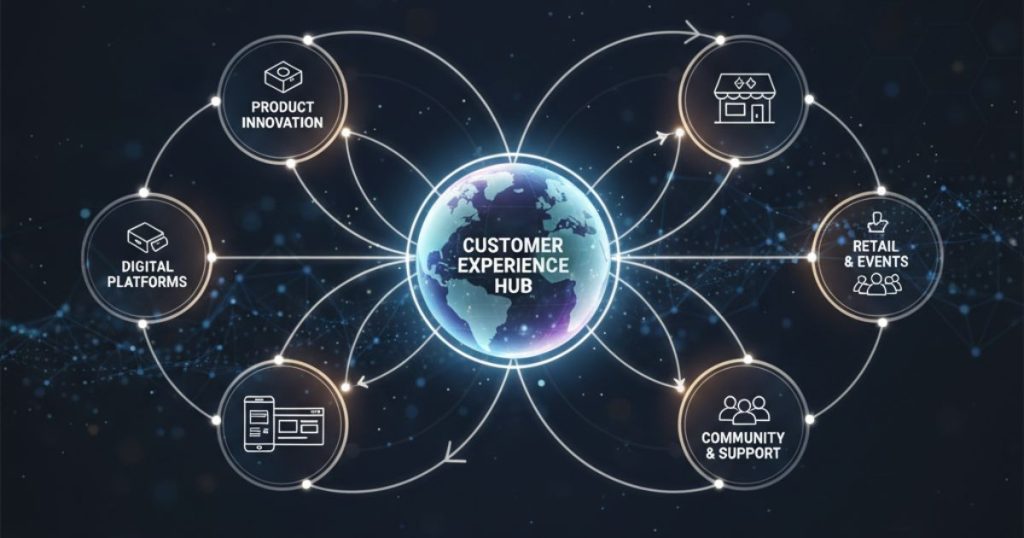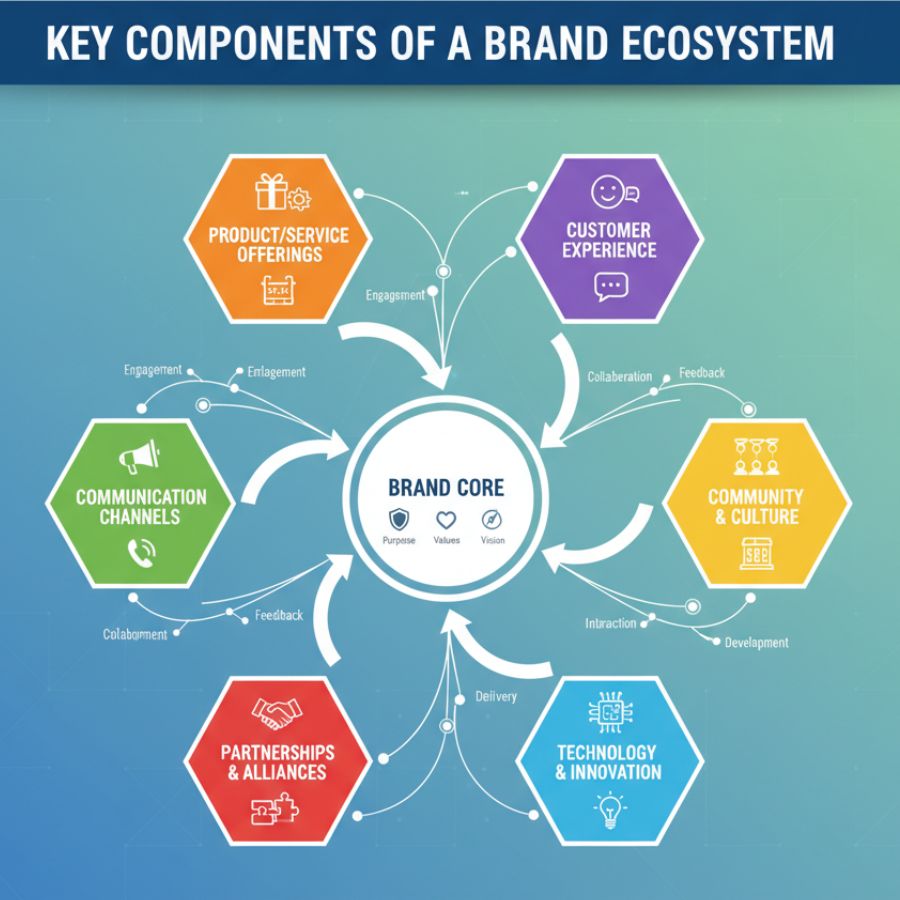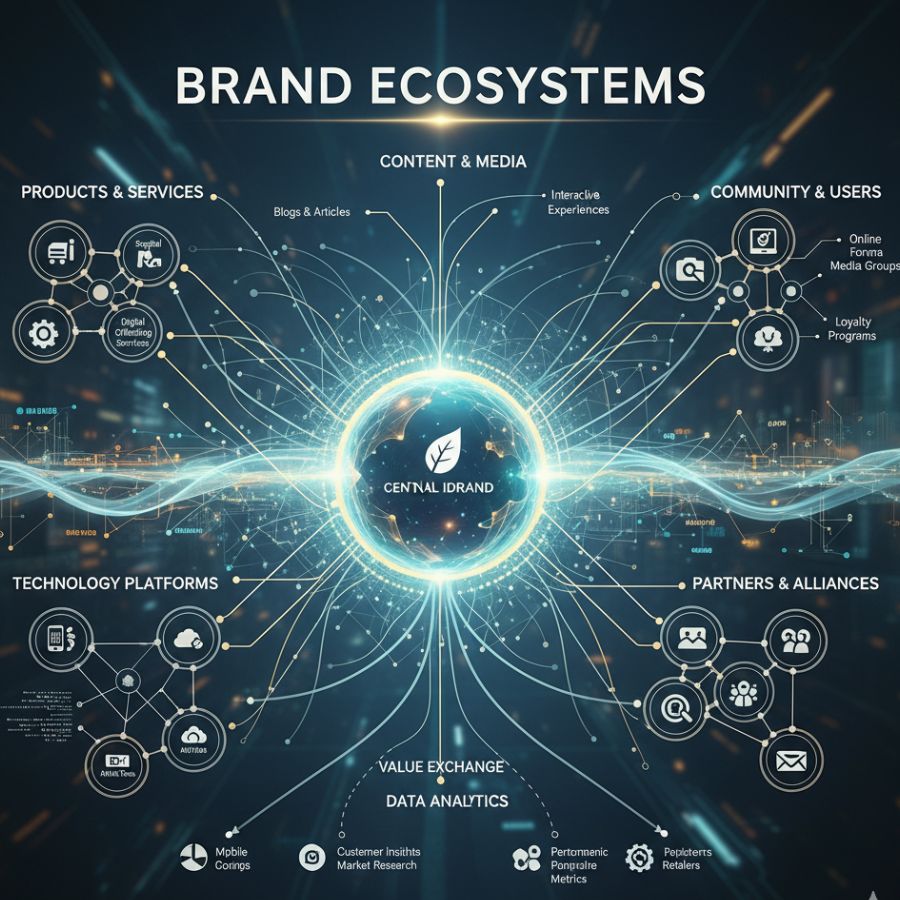Brand Ecosystems: How to Craft Cohesive Experiences That Engage

The digital marketplace is more connected than ever, and a brand is no longer defined by a logo or slogan alone. Customers engage with brands through various channels, including social media, websites, emails, in-store experiences, and customer support. This fragmented journey makes a brand ecosystem essential. A cohesive brand ecosystem ensures consistent messaging, seamless experiences, and stronger brand recognition across every touchpoint.
Here, we explore what a brand ecosystem is, why it matters for business growth, and how to build and optimize one that drives customer engagement, loyalty, and long-term success.
What Is a Brand Ecosystem?
A brand ecosystem refers to the network of all elements that comprise a brand’s presence. This includes visual identity, brand voice, customer touchpoints, digital platforms, partnerships, and company culture. Instead of looking at these separately, a brand ecosystem brings them together. When all parts work together, brands can create smooth customer experiences, build recognition, and earn trust and loyalty.
Why Cohesive Branding Matters
Consistency helps build credibility. When customers encounter the same message, style, and tone across social media, websites, emails, and in-person interactions, they trust the brand more. A cohesive brand strategy reduces confusion, facilitates easier decision-making, and strengthens emotional connections.
A strong brand ecosystem also helps teams work better together. Brands that deliver clear and consistent experiences stand out in crowded markets. They earn brand loyalty, gain advocates, and can charge higher prices. Cohesive branding is not optional—it is essential for brands that want to grow and succeed.
Key Components of a Brand Ecosystem

Visual Identity
Visual identity includes logos, color palettes, typography, imagery, and graphic elements. It’s the most immediate representation of your brand and shapes first impressions. A well-defined visual system ensures consistency across digital and physical assets, from your website and social media posts to packaging and event signage. By creating comprehensive brand guidelines and asset libraries, you empower teams and partners to maintain visual coherence.
Brand Voice and Messaging
Your brand voice is the personality and tone you use in communications. Whether you’re playful and conversational or authoritative and informative, consistent messaging strengthens brand recognition and fosters deeper connections. Develop a messaging framework that outlines key themes, value propositions, and style guidelines to guide content creation across various channels, including blog posts, emails, ads, and customer support interactions.
Dig Deeper: What is Brand Voice?
Customer Touchpoints
Every interaction—from online or offline—counts. Customer touchpoints include website visits, social media engagements, mobile apps, advertising, in-store experiences, packaging, and post-purchase support. Mapping these touchpoints helps you identify gaps and opportunities to create seamless journeys. When each interaction reflects your brand ecosystem, customers experience a unified narrative that guides them from awareness to advocacy.
Technology and Platforms
Technology underpins modern brand ecosystems. From content management systems and customer relationship management (CRM) tools to marketing automation and analytics platforms, these technologies must integrate smoothly. Data flows between systems enable personalized experiences and informed decision-making. Prioritize scalable and interoperable solutions that support your brand’s growth trajectory and maintain ecosystem cohesion.
Building Your Brand Ecosystem: A Step-by-Step Guide
Creating a cohesive brand ecosystem requires deliberate planning and cross-functional collaboration. Follow these steps:
- Audit Existing Assets: Review all brand elements, touchpoints, and platforms to ensure consistency and alignment: document inconsistencies, redundancies, and performance gaps.
- Define Your Framework: Establish core brand principles, visual identity guidelines, and messaging pillars to create a cohesive brand identity. Develop a centralized brand playbook that is accessible to all stakeholders.
- Align Technology Stack: Evaluate and integrate tools that support content management, customer data, and analytics. Ensure seamless data exchange for unified experiences.
- Train Your Team: Conduct workshops to familiarize employees and partners with brand guidelines and processes. Encourage feedback and iterative improvements.
- Implement and Monitor: Roll out cohesive brand elements across channels. Utilize analytics to monitor key metrics and refine your ecosystem based on performance insights.
Case Studies: Brands Excelling in Ecosystem Cohesion
Example 1: A Global Retailer
A leading global retailer revamped its brand ecosystem by unifying its e-commerce platform, mobile app, and physical stores under a single visual and messaging framework. Consistent in-store signage, personalized push notifications, and seamless online-to-offline loyalty programs increased customer engagement by 25% and boosted repeat purchases by 18% within six months.
Example 2: A Tech Startup
A fast-growing tech startup focused on sustainability created a brand ecosystem that integrated its product design, digital experiences, and community initiatives. By aligning its eco-friendly values in packaging, website content, social media campaigns, and in-person workshops, the startup achieved a 40% increase in brand advocacy. It secured partnerships with two major industry players.
Measuring and Optimizing Your Brand Ecosystem

To gauge the health of your brand ecosystem, track quantitative and qualitative metrics. Key performance indicators may include brand awareness, Net Promoter Score (NPS), customer retention rate, and consistency scores derived from brand audits. Collect customer feedback through surveys and social listening to uncover sentiment and pinpoint areas of friction.
Continuous optimization is critical. Regularly revisit your brand guidelines, update your technology integrations, and refine messaging based on market trends and customer insights. A dynamic brand ecosystem that evolves in response to your audience’s needs will remain resilient and relevant.
Conclusion
Building a strong brand ecosystem takes strategy, planning, and ongoing effort. Aligning your brand identity, messaging, customer touchpoints, digital channels, and marketing efforts creates a seamless customer experience. A unified brand approach builds brand recognition, trust, and loyalty. It also helps your business stand out in a competitive market and strengthens your brand positioning. Embrace the ecosystem mindset, and your brand can grow, connect with customers, and achieve long-term success.







